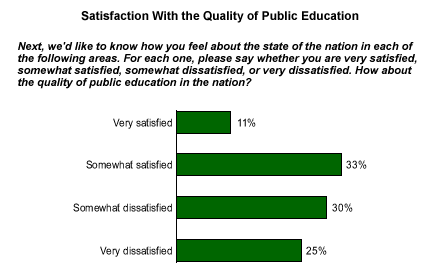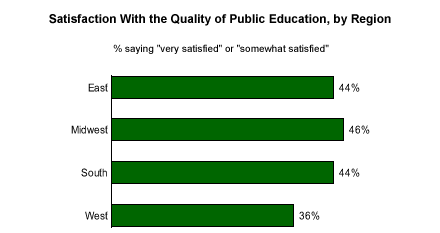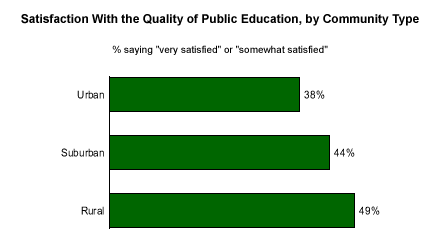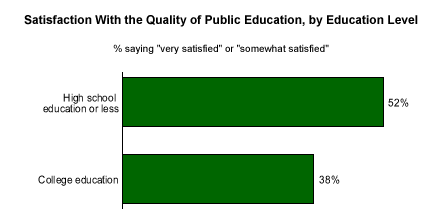President George W. Bush spent the better part of last week crisscrossing the nation to tout his administration's education policies and programs. It may have been a tough sell, given that in general, Americans have tended to be somewhat more dissatisfied than satisfied with the quality of public education in this country.
A three-year aggregate of Gallup data (2002-2004)* on attitudes toward the public schools indicates that 44% of Americans are very (11%) or somewhat (33%) satisfied with public education, but a slight majority, 55%, are either very (25%) or somewhat (30%) dissatisfied. Despite these negative perceptions about the quality of the U.S. education system, past surveys have demonstrated that most Americans are happy with their own educations and the educations their children receive.

Americans tend to base their perceptions of the state of the educational system on what they see and hear in the media, what they personally experience, and the experiences of their peers. Jerry Voron, a photographer from Pittsburgh, says he is satisfied with the quality of public education in the nation because of what he sees, rather than what he reads. "Whenever I help my son with his math homework, I'm impressed by how much more advanced the work is now than when I was in school," he says.
West Least Satisfied With Public Schools
Americans living in the western part of the United States are slightly less likely than residents of other parts of the country to say they are satisfied with the quality of public education in the nation. According to Gary Gordon, Gallup's Global Practice Leader for Education, "The regional differences from the West are not too surprising because of the long-term impact of Proposition 13 in California [passed in 1978], which forced major cutbacks in education. That part of country saw significant budget reductions in Oregon and Washington, as well."

Urban Schools a Concern
City dwellers are less satisfied with the quality of public education than others are -- 38% of Americans living in urban areas are dissatisfied, compared with 44% of suburbanites and 49% of those who live in rural areas.
However, there appears to be no difference in satisfaction with the quality of public education according to race. Forty-two percent of nonwhite Americans, who tend to live in more urban areas, are satisfied with public education, compared with 44% of whites. In fact, 15% of nonwhites say that they are very satisfied with public education in the United States, versus 10% of whites who are very satisfied.

Level of Education Informs Opinions
Past Gallup polling has also shown that the more education people receive, the more likely they are to be satisfied with their own educations. But the reverse appears to be true when it comes to perceptions of public education in general -- those with higher levels of education tend to be more dissatisfied. It may be that Americans with more education have higher expectations, and a higher level of awareness of the education problems the country is facing.

Bottom Line
Concerns about education make the list of "most important problems" facing the country virtually every time Gallup asks the question. (See "Education a Fixture on ‘Top Problem' List" in Related Items.) In early May, education appeared among the top non-economic problems cited by Americans, just below the top problems of the war in Iraq and terrorism.
"It's disappointing that less than half of Americans are satisfied with the quality of public education in the nation, but it is not surprising," says Gordon. "Our attitudes toward the nation's schools come principally from the news media, and most of this information is negative. The key for school districts is to communicate the successes of students to parents -- and to non-parents as well, since they make up about 70% of voting citizens in most communities."
*Findings are based on aggregated data from the following three polls of approximately 3,000 national adults, conducted Jan. 7-9, 2002, Jan. 13-16, 2003, and Jan. 12-15, 2004. For results based on this total sample of national adults, one can say with 95% confidence that the maximum margin of sampling error is ±2 percentage points.